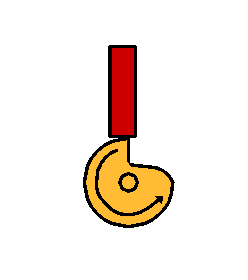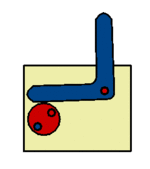Radial Cam: Difference between revisions
From DT Online
mNo edit summary |
(Added lever follower animation) |
||
| Line 1: | Line 1: | ||
[[File:SnailCam.gif| | [[File:SnailCam.gif|300px|right]][[File:Lf.gif|150px|right]] | ||
[https://en.wikipedia.org/wiki/Cam '''Radial Cams'''] are one of the most common types of ‘cam’. The ‘radial cam’ is a rotating plate or disc with an outer circumference shaped to produce a required movement ''(usually linear)'' to a [https://en.wikipedia.org/wiki/Cam_follower '''‘follower’'''] which is held against it. | [https://en.wikipedia.org/wiki/Cam '''Radial Cams'''] are one of the most common types of ‘cam’. The ‘radial cam’ is a rotating plate or disc with an outer circumference shaped to produce a required movement ''(usually linear)'' to a [https://en.wikipedia.org/wiki/Cam_follower '''‘follower’'''] which is held against it. | ||
Revision as of 09:51, 19 April 2016
Radial Cams are one of the most common types of ‘cam’. The ‘radial cam’ is a rotating plate or disc with an outer circumference shaped to produce a required movement (usually linear) to a ‘follower’ which is held against it.
The radial cam may be a simple recognisable shape, such a circle or ellipse, or may be more a complex profile producing variations in the speed and magnitude of the follower movement, moments of 'dwell’ or a 'sudden drop’ - as with the 'snail cam’ shown. The sequence of follower movements is designed using a Displacement Diagram and the cam shaped accordingly.
A 'follower’ may simply be a rod, constrained by guides, to slide up and down in a reciprocating motion, as the cam, which it rests upon, rotates underneath it - i.e. as push-rods of some car engines are driven up and down by the engine camshaft. The ends of the 'follower’ may be flat, round, wedge-shaped or pointed for different service conditions or may terminate with a roller for increased wear resistance.
Followers may also be in the form of a lever and when used against these, the cam generates an oscillatory movement.

